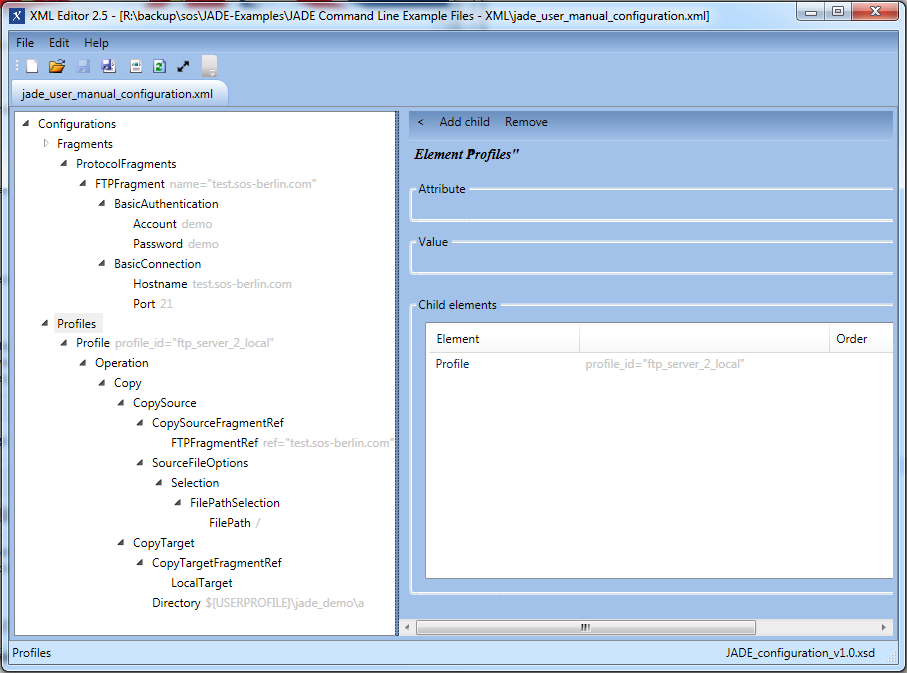Introduction
Use of the JADE Client will be significantly changed with the introduction of an XSD schema and XML configuration files with Release 1.11.
Example configuration and command line calls for the XML-based configuration and its predecessor - text-based settings files - are presented on this page for comparison.
settings.ini file transfer configuration - available up to Release 1.10.x
File transfer configurations are stored in a settings.ini file.
Individual parameters are grouped together in profiles that can be reused and allow a 'single point of definition' approach to be followed.
Parameters that can be defined separately for the source and target parts of the transfer - for example, the host name and port number - are set with the source_ and target_ prefixes.
This is illustrated in the following example profile:
[ftp_server_2_local]
;;
operation = copy
;;
source_host = test.sos-berlin.com
source_protocol = ftp
source_port = 21
source_user = demo
source_password = demo
source_dir = /
;;
target_host = localhost
target_protocol = local
target_dir = ${USERPROFILE}\jade_demo\a
Running a file transfer profile
A file transfer is started by specifying a settings.ini file and the profile in that file that is to be used.
For example, the profile listed above is called using:
jade.cmd -settings="%USERPROFILE%\jade_demo\jade_settings.ini" -profile="ftp_server_2_local"
./jade.sh -settings="${HOME}/jade_demo/jade_settings.ini" -profile="ftp_server_2_local"
Limitations of the settings.ini file approach
Whilst this approach is relatively straightforward to understand when used with simple file transfer situations:
- it is prone to configuration errors and
- becomes difficult to understand and therefore maintain when advanced and complex file transfer configurations are implemented.
More Information
- Detailed descriptions of the parameter configuration and the use of profiles is available in our JADE Tutorials. These include examples that can be tested using our demonstration FTP and SFTP servers. A download containing a configuration file for the tutorial examples is also available.
- A Parameter Reference and a Parameter Mapping table are also available
XML-based file transfer configuration - available from Release 1.11 onwards
The XML file transfer configuration introduced with Release 1.11 of JADE allows parameter dependencies in JADE to be validated before the configuration file is transferred to an operating environment.
Dependencies and conflicts between configuration elements are avoided through the use of an XSD schema
An XML editor is available that will simplify the creation and validation of schema-compatible file transfer configurations.
The basic principles behind the organization of the schema and parameters will be described on this page. A detailed description of individual parameters can be found in our Parameter Reference and a description of the considerations involved in configuration of a simple file transfer can be found in the Simple File Transfer with Basic Authentication example.
The following screen shot of the SOS XML Editor shows the configuration of a simple FTP file transfer example - in this case files are downloaded from the SOS demo server to the local file system.
- The left hand pane of the Editor shows the
The following code block shows the XML configuration file for the test host FTP file transfer example shown in the XML Editor screen shot above in XML form:
<?xml version="1.0" encoding="UTF-8"?>
<Configurations>
<Fragments>
<ProtocolFragments>
<FTPFragment name="demo@test.sos-berlin.com">
<BasicAuthentication>
<Account><![CDATA[demo]]></Account>
<Password><![CDATA[demo]]></Password>
</BasicAuthentication>
<BasicConnection>
<Hostname><![CDATA[test.sos-berlin.com]]></Hostname>
<Port><![CDATA[21]]></Port>
</BasicConnection>
</FTPFragment>
</ProtocolFragments>
</Fragments>
<Profiles>
<Profile profile_id="ftp_server_2_local">
<Operation>
<Copy>
<CopySource>
<CopySourceFragmentRef>
<FTPFragmentRef ref="demo@test.sos-berlin.com" />
</CopySourceFragmentRef>
<SourceFileOptions>
<Selection>
<FilePathSelection>
<FilePath><![CDATA[/]]></FilePath>
</FilePathSelection>
</Selection>
</SourceFileOptions>
</CopySource>
<CopyTarget>
<CopyTargetFragmentRef>
<LocalTarget />
</CopyTargetFragmentRef>
<Directory><![CDATA[${USERPROFILE}\jade_demo\a]]></Directory>
</CopyTarget>
</Copy>
</Operation>
</Profile>
</Profiles>
</Configurations>
Although longer and seemingly more complex than the settings file configuration version shown above, the XML code for this example was produced using the graphical editor and therefore has been validated against the JADE Client XSD Schema. It is error and conflict free and dependencies are correctly specified.
Running a file transfer profile
A file transfer is started by specifying an XML configuration file and the profile in that file that is to be used.
For example, the profile listed above is called using:
jade.cmd -settings="%USERPROFILE%\jade_demo\jade_user_manual_configuration.xml" -profile="ftp_server_2_local"
./jade.sh -settings="${HOME}/jade_demo/jade_user_manual_configuration.xml" -profile="ftp_server_2_local"
Moving from a Settings File to an XML Configuration
Comparison of the two approaches reveal a significant difference in the concept behind the two approaches to configuration:
- Settings file configuration
Parameters such as host, protocol, user, password and dir (directory) are usually grouped separately in the settings file configuration according to whether they apply to the transfer source or target. This usually has no functional meaning (the files are processed from top to bottom) and is partly simply for convenience (grouping parameters together makes them easier to find) and partly to allow their reuse in the form of so-called profile fragments if required. - XML configuration
- Parameters are divided up between profile and fragment branches. (Note that these expressions are defined differently to elements in the settings file configuration with the same names.)
- authentication and connection parameters (Account & Password and Hostname & Port respectively) and the protocol (defined through the use of FTP) are part of the Fragments branch of the configuration.
- the operation (copy) and the source and target file paths (FilePath and LocalTarget respectively) are specified in the Profiles branch.
- the CopySourceFragmentRef element refers to the FTPFragment specified in the Fragments branch
- The division between Fragments and Profiles branches allows the reuse of elements whilst working within the strict hierarchical structure of XML.
- The use of a reference in the Profiles branch (in the example, using the CopySourceFragmentRef element) to specify the authentication and connection parameters in the Profiles branch allows any number of Profiles elements to be defined and specified as required.
- Parameters are divided up between profile and fragment branches. (Note that these expressions are defined differently to elements in the settings file configuration with the same names.)
More Information
See JADE User Manual - XSD Schema article for more detailed information about the XML configuration.
Pages
Navigation
